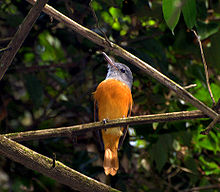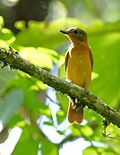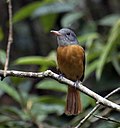| Attila | |
|---|---|

| |
| Grey-hooded attila | |
| Scientific classification | |
| Domain: | Eukaryota |
| Kingdom: | Animalia |
| Phylum: | Chordata |
| Class: | Aves |
| Order: | Passeriformes |
| Family: | Tyrannidae |
| Genus: | Attila Lesson, RP, 1831 |
| Type species | |
| Attila brasiliensis = Muscicapa spadicea Lesson, 1831 | |
| Synonyms | |
|
Dasycephala | |
Attila is a genus of tropical passerine birds, the attilas. They belong to the tyrant flycatcher family. The species in this genus have large heads and hooked bills; they are markedly predatory and aggressive for their size – hence the scientific and common names, which refer to Attila the Hun.
Taxonomy
The genus Attila was introduced in 1831 by the French naturalist René Lesson to accommodate a single species, the bright-rumped attila, which is therefore considered as the type species. The genus name is from Attila the Hun who attacked Rome and Orléans in the 5th century.
The genus contains seven species:
| Image | Scientific name | Common Name | Distribution |
|---|---|---|---|
 |
Attila phoenicurus | Rufous-tailed attila | southern Paraguay and Brazil; also extreme northeast Argentina, Bolivia and southern Venezuela |
 |
Attila cinnamomeus | Cinnamon attila | Brazil, Colombia, Venezuela, Guyana, Suriname, and French Guiana; also Amazonian Ecuador, Peru, and regions of Bolivia. |
 |
Attila torridus | Ochraceous attila | Colombia, Ecuador, and Peru |
 |
Attila citriniventris | Citron-bellied attila | Brazil, Colombia, Ecuador, Peru, and Venezuela. |
 |
Attila bolivianus | White-eyed attila | Bolivia, Brazil, Colombia, Peru, and possibly Ecuador. |
 |
Attila rufus | Grey-hooded attila | Brazil. |
 |
Attila spadiceus | Bright-rumped attila | northwestern Mexico to western Ecuador, Bolivia and southeastern Brazil, and on Trinidad |
References
- "Tyrannidae". aviansystematics.org. The Trust for Avian Systematics. Retrieved 2023-07-16.
- Lesson, René (1831). Traité d'Ornithologie, ou Tableau Méthodique (in French). Vol. 1. Paris: F.G. Levrault. p. 360 (livr. 5). Published in 8 livraisons between 1830 and 1831. For the publication date see: Dickinson, E.C.; Overstreet, L.K.; Dowsett, R.J.; Bruce, M.D. (2011). Priority! The Dating of Scientific Names in Ornithology: a Directory to the literature and its reviewers. Northampton, UK: Aves Press. p. 119. ISBN 978-0-9568611-1-5.
- Traylor, Melvin A. Jr, ed. (1979). Check-List of Birds of the World. Vol. 8. Cambridge, Massachusetts: Museum of Comparative Zoology. p. 186.
- Jobling, James A. (2010). The Helm Dictionary of Scientific Bird Names. London: Christopher Helm. p. 60. ISBN 978-1-4081-2501-4.
- Susan Myers (25 October 2022). The Bird Name Book : A History of English Bird Names. Princeton University Press. ISBN 978-0-691-23685-8.
- Gill, Frank; Donsker, David; Rasmussen, Pamela, eds. (January 2023). "Tyrant flycatchers". IOC World Bird List Version 13.1. International Ornithologists' Union. Retrieved 21 March 2023.
Further reading
- Hilty, Steven L. (2003): Birds of Venezuela. Christopher Helm, London. ISBN 0-7136-6418-5
- Stiles, F. Gary & Skutch, Alexander Frank (1989): A guide to the birds of Costa Rica. Comistock, Ithaca. ISBN 0-8014-9600-4
| Taxon identifiers | |
|---|---|
| Attila | |
This article about a tyrant flycatcher is a stub. You can help Misplaced Pages by expanding it. |
